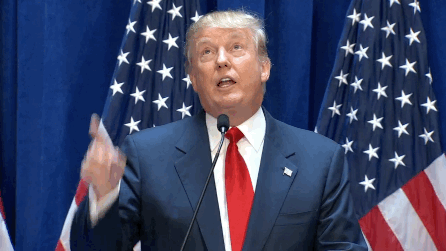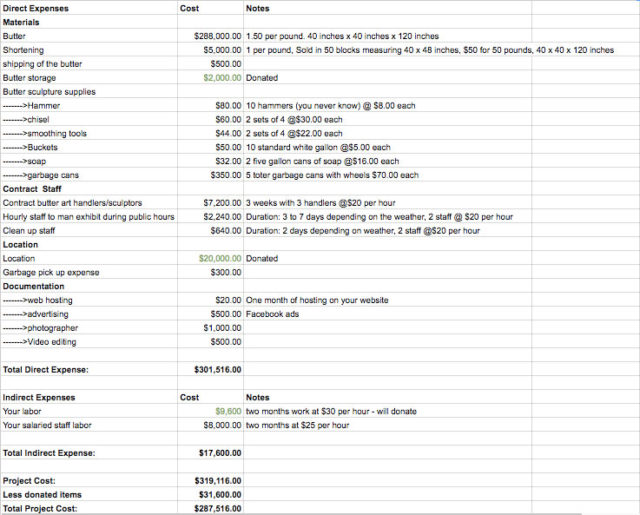
Editor’s Note: This post is an auxiliary component of The AFC Workshops: 21st Century Survival for Artists, a two-part series of courses led by artists, educators and art-world insiders designed to give artists the tools to get ahead. Eleanor Whitney, who led our “Grant Applications, The TL;DR Overview” course has written a post on grant writing and is back today to discuss budgeting. Whitney is a Brooklyn-based community manager and marketer, writer, and educator. She is currently the Community Marketing Manager at Dev Bootcamp and has also worked at Shapeways, the New York Foundation for the Arts, the Rubin and the Brooklyn Museum. Her budgeting workbook pages can be found here.
For many artists, budgets are terrifying. The reasons for this differ—some of us never did well in math class, others of us don’t know how to use excel, others still worry that making a bad budget will reveal them to be unfit to do pretty much anything.
The fact is, none of that is true. It’s possible to put together a complete budget with little pain or anxiety. To demonstrate, though, how I chose an inspiration that is likely to terrify us all: Republican Presidential Candidate Donald Trump’s face carved in 20 feet of butter. The thought being, that you if you can live with the idea of of a larger than life sculpture of Donald Trump, you can definitely tell that story via a budget. So, let’s roll our sleeves up and get down to planning the nitty gritty of this thing—scope, expenses and income.

SCOPE
How big is your project? In this case, pretty huge. You’ve decided to make 20-foot high, giant public sculpture of Donald Trump’s face made out of butter that will be sculpted by a team of artists and will then melt in the New York summer heat. The whole process will be meticulously documented over video, edited to a custom soundtrack and spread as viral content on the web.
That’s a lot to pull off, though—in fact, the potential effort and cost might be enough that you decide that it’s not feasible. Perhaps the project would be more effective if it shrunk to the size of a toy figure and placed on the floor so it could be stepped upon? This would lessen the budget and the timeline but it will not affect Trump’s face, which will still be destroyed. Never let the scope of a project undermine your artistic intent and the message you want to get across.
Knowing the scope of the project will help you determine what resources you will need to realize it.

EXPENSES
It’s easier to start a budget with a list of expenses, because it identifies the essential materials the project needs to exist. Since any expense list begins with a brainstorm, let’s have a bit of fun and do one for the Donald Trump butter face.
Cost of butter
How many square feet of butter will you need to build a 20 foot high Trump? I did a bit of initial research and learned that a solid butter statue was going to be exorbitantly expensive. So, I decided to cut that butter with shortening to save on costs.
Other questions to think about: How are you going to ship that much butter to your site? Are there arts friendly butter shippers who can give you a good rate?
Cost of manufacturing
Do you need an assistant to make a 20 foot high Donald Trump Face? The answer to this is yes. Don’t try to do this on your own.
How much of your own time will this take and how much do you pay yourself?
What tools do you need? Remember, while the material may call for butter knives, always consider the subject matter. In this case, it may require a more brutal rendering instrument. Stock up on hammers. Calculate that into your costs.
Cost of Location and Clean Up
Where will you launch this project? Can you secure partners who see this project as essential to help you launch this project? How long will it be up for and who will clean up the mess when you’re done?

Documentation
Professional photographer, editing and post production.
As you can see above, I’ve organized these items into broad categories such as with specific items listed below them. I’ve also done a little research, as you’ll need to do too. Figure out how much the supplies you need cost, how much you’ll need to pay for professional services, and how much to pay yourself. At this stage in the game, don’t worry about spending too much or too little. The idea is to get a ballpark figure of how much you could spend and then figure out what you can add or cut based on your revenue.
I’ve also organized this into categories with line items, and costs and add up a total for each category and then for the expense budget over all. You’ll need to do this too.
You’ll notice we’re spending quite a bit. For this Trump project to happen it’s going to cost close to $300,000. How much are you willing to spend of your money and other people’s money to make this Donald Trump sculpture live? Is the Trump butterface worth all this effort? THE ANSWER IS YES.
Remember the prices you find are an estimation, not a determination, of what your project will cost. You can always adjust the scope of the project, if you decide the costs outweigh the benefit of this sculpture.

INCOME
When I worked at NYFA, most artists thought budgets were just a list of expenses. When they thought of budget they thought, “How much will the project cost?” instead of “How much does it cost and how will I pay for it?” To tell a complete story a budget has to have two sides: expenses and income.
Income is the column most artists I spoke to at NYFA willed themselves to forget but without any income most projects can’t exist, so it’s important to identify where your revenue will come from.

Income can come in these forms:
- Earned income (what you make from selling a product)
- Contributed income (money you raise from grants, crowdfunding or fundraising events)
- Barter or in-kind support (the value of donated items and gifts)
Brainstorm all the ways you will generate income for this project. Trump Butter Face is an ambitious and expensive project so you will require more income.
Luckily, you anticipate the project to have wide appeal so it is likely to do well on a crowdfunding site, and since it also provides a public benefit, grants can be secured to make this project happen.
These income streams, though, have costs associated with them, so it’s useful to return to your expense sheet and consider how much your fundraising costs will be.
Similar to expenses, create broad categories based on the areas above, and details on line items.

As I’ve done in my budget above, note whether your income is projected (you don’t have it yet) or received (you have it). Add up your income. Compare the two. Don’t panic if they don’t match. You have not failed at budgeting. While we’re always told that not having a “balanced budget” (that is that expenses and income even out) is a bad thing, the most important thing with creating a budget is to know where you stand so you can plan for there. Do you need more money to launch a project effectively? Awesome, now you know and you can go out and get it. One caveat: When applying for grants potential funders will want to see both the income and expenses for a project, including in-kind support.
If you are planning to barter or receive in-kind support for a project, it’s important to have an idea of the relative value of those services. Grants will require this information, and if you want to replicate the project, you’ll need it too. You can’t rely on consistent in-kind and barterable goods.

Now that you’ve drafted your budget, you can revise it! Show it to a few friends who are good with budgets and have made one before. Ask them if the expenses you have included seems essential and relevant to the project and if your estimated income looks realistic. Also reach out to a few butter experts to see if they have ideas about how to save on costs. (I cut the butter with shortening once I saw how expensive executing the project with butter alone would be.)
As you work on your project keep track of your expenses, save your receipts, and note how much time you spend on your project. Did you get an invoice with your butter order? Did sculpting Donald’s hair piece take you 10 hours when you thought it would take 2? Are you spending more or less than you thought? What does that tell you about how you will need to adjust or revise your plans? If it’s taking you too long to render Trump in butter yourself, can you afford to pay someone to help you?
Making your budget tell a coherent story is tedious, but it will spare you anxiety in the long run. When you have clarity on how much you have to spend, and how much you need to make, you free up more time and energy to actually make your work. That’s pretty valuable at every stage of the game and can be the difference between projects that never get off the ground and those that make waves across the world. As the author of your project and your budget, those waves are yours to make.


Comments on this entry are closed.